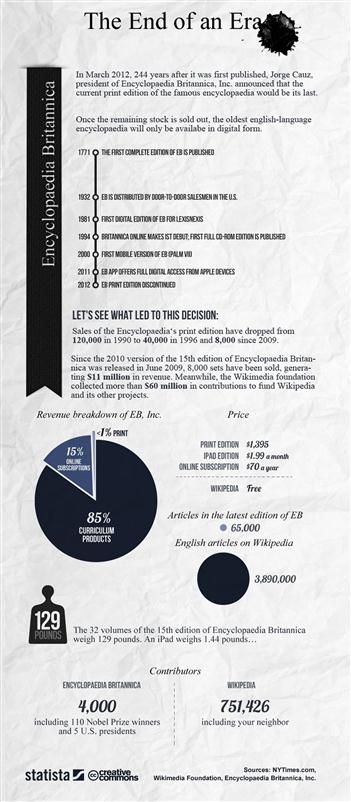Introduction to Open-Source Hardware for Science
Abstract
As the successful free and open-source process is being applied to hardware, an opportunity has arisen to radically reduce the cost of experimental research in the sciences. This book is relevant to every scientist and engineer who does experimental research and employees of scientific funding agencies. A revolution is occurring where formally highly specialized, high-cost scientific equipment can be fabricated using digital designs at factor of 10–100 cost reductions. This makes science much more accessible to the general population, DIY and amateur scientists, grade school science labs, etc. It also reduces costs for our most advanced research institutes. This chapter defines the basic terms of open-source software and discusses the rise of the open-source hardware revolution and how it impacts science.
Keywords
Free and open-source hardware (FOSH); Free and open-source software (FOSS); Free libre open source software (FLOSS); Open-source hardware (OSH); Open-source
1.1 Introduction
By any standard, the process of development and licensing for free and open-source software, which is discussed in Chapters 2 and 3, has been a success. Because of this success, the method is now being applied to hardware. Thus, an opportunity has arisen to radically reduce the cost of experimental research in the sciences [1]. This opportunity has the potential to reduce your research costs and make your laboratory more productive—while at the same time vastly expanding the scientific user base. Specifically, this book focuses on the combination of open-source microcontrollers covered in Chapter 4 and open-source 3-D printing reviewed in Chapter 5. These two tools running on free open-source software enable the development of powerful research tools at unprecedented low costs. Chapter 6 provides several detailed examples of these tools for a wide range of science and engineering disciplines. Then, in Chapter 7, these developments and their likely trajectories in the future are explored and illustrated with numerous examples to lay out a path of mutually reinforcing and accelerating free and open-source scientific hardware development for the benefit of science.
1.2 What is Open Source?
The term “open source” emerged during a strategy session between several hackers1 of the early open software movement [2]. Free and open-source software (F/OSS, FOSS) or free/libre/open-source software (FLOSS) is a software that is both a free software and an open source. FOSS is a computer software that is available in source code (open source) form and that can be used, studied, copied, modified, and redistributed without restriction, or with restrictions that only ensure that further recipients have the same rights under which it was obtained (free or libre). Free software, software libre or libre software is software that can be used, studied, and modified without restriction, and which can be copied and redistributed in modified or unmodified form either without restriction or with restrictions that only ensure that further recipients have the same rights under which it was obtained and that manufacturers of consumer products incorporating free software provide the software as source code. The word “free” in the term refers to freedom (liberty) and is not necessarily related to monetary cost. Although FOSS is often available without charge, it is not bound to such a restriction.
GNU/Linux (normally called just Linux), perhaps, is the best example of an open-source project created by the many. Linus Torvalds originally developed Linux in 1994 as a little hacking project to replace a program called Minix, which was a teaching tool in computer science courses. He released the source code to everyone using the Internet. The hacker and the software developer community at-large were immediately enthralled by Linux and began contributing improvements to the source code. The program went from being a little side project to a full PC-based operating system to which more than 3000 developers distributed over 90 countries on five continents contributed. In the first few years of its development, more than 15,000 people submitted code or feedback to the Linux community. Linux went from consisting of a few hundred lines of code to several millions of lines of code. Despite this rapid growth and large developer community, the reliability and quality of the operating system were ranked very highly [3]. These observations provide support of Raymond’s claim that “given enough eyeballs, all bugs are shallow” [4], meaning that problems become easier to solve with more collaborators. This is the fundamental strength of the open-source paradigm. We are all smarter than any one of us. Although the basics of open source remain the same since the start of the movement, the current definition of open source has been expanded to include such criteria as free redistribution rights and no discrimination against people/groups in accessing source code [5].
As much of the Internet now relies on FOSS, we all use it every day. Even if your laptop is not running a version of Linux like the one I am typing on now (System 76 running Ubuntu2), the back ends of the world’s most popular websites are all run on open-source software (e.g. Google, Facebook, etc.). FOSS is not only just as good as commercial software—it is often superior. If an open-source software such as GNU/Linux is compared head-to-head against Microsoft’s centralized and closed system of software development, a perhaps surprising result surfaces. A neutral technical assessment finds that open-source software, developed in the early days mostly by unpaid volunteers, is often of superior quality to the software developed by one of the most powerful companies in the history of the world employing unquestionably extremely intelligent people [6]. This remarkable result stands against conventional wisdom that would argue the profit motive and market forces would enable Microsoft to develop superior software to any random group of volunteers. Microsoft is a large company, with annual revenue of over US$40 billion, yet many of its products suffer from technical drawbacks that include bloat, lack of reliability, and security holes. Microsoft remains dominant in the PC market largely because of inertia, but Linux eats up an ever larger market share (particularly in servers), because open source is simply more efficient and adaptable than closed, hierarchical systems [7]. This is due, historically at least, in a large part because a lot more people collaborate on Linux than on Microsoft products. Whereas Microsoft might utilize a few thousand programmers and software engineers to debug their code, the Linux community has access to hundreds of thousands of programmers debugging, rewriting, fixing, making suggestions and submitting code.3 Eric Raymond in the Cathedral and the Bazaar argued that open source was a fundamentally new way to create and design technology that relied on the “eyeballs” of the many instead of the minds of the few. Using the cathedral and bazaar analogy, Raymond claimed that open source, drawing from the rich, nonhierarchical, gift-based culture of hackers, was similar to the bazaar where everyone could access and contribute equally in a participatory manner. This type of mass-scale collaboration is driving the success of Web 2.0 applications that emphasize online collaboration and sharing among users (examples include social networking sites and wikis such as Wikipedia). Wikipedia is a particularly good example because both the software is open source, as is the development method of the content, which has proven both accurate [8] and far superior in terms of both total and up-to-date coverage compared to conventional for-profit encyclopedia generation as summarized in Figure 1.1 [9].
This superior software development method has even developed something of an actual “movement”. The FOSS movement emerged as a fundamentally new, decentralized, participatory and transparent system to develop software in contrast to the closed box, top-down and secretive standard commercial approach [4,10–12]. FOSS provides (1) an alternative to expensive and proprietary systems, (2) a reduction in research and development costs, (3) a viable alternative to the linear hierarchical structure used to design any type of technology-based products and (4) the efficiency of collaboration, demand-driven innovation and the power of the Internet to provide for a global collective good. Due to this tremendous success of FOSS development, the concept has spread to areas such as education [13,14], appropriate technology for sustainable development (called open-source appropriate technology) [15–18], science [19], nanotechnology [20–22] and medicine [23,24]. Both academic and nonacademic scientists are accustomed to this line of thinking as both historical knowledge sharing and the Internet enabled new era of networked science have demonstrated the enormous power of working together [25–27].
1.3 Free and Open-Source Hardware
These open and collaborative principles of licensing FOSS are easily transferred to scientific hardware designs [1]. Thus, free and open-source hardware (FOSH) is a hardware whose design is made publicly available so that anyone can study, modify, distribute, make, and sell the design or hardware based on that design. The most successful enabling open-source hardware project is the Arduino electronic prototyping platform4, which we will investigate in detail in Chapter 4. The $20–60 Arduino is a powerful, yet easy-to-learn microcontroller that can be used to run a burgeoning list of scientific apparatuses directly including the already developed Polar Bear (environmental chamber—detailed in Chapter 4), Arduino Geiger (radiation detector)5, pHduino (pH meter)6, Xoscillo (Oscilloscope)7, and OpenPCR (DNA analysis)8. However, one of the Arduino’s most impressive technological evolution-enabling applications is with 3-D printing.
Using an Arduino as the brain, 3-D printers capable of additive manufacturing or additive layer manufacturing from a number of materials including polymers, ceramics and metals have been developed. The most popular of these 3-D printers is the RepRap, named because it is a self-replicating rapid prototyping machine.9 Currently, the RepRap (Figure 1.2), which uses fused-filament fabrication of complex 3-D objects, can fabricate approximately 50% of its own parts and can be made for under $1000 [28]. The version we will explore in Chapter 5 can be built for about $500 and assembled in a weekend. This ability to inexpensively and freely self-replicate has resulted in an explosion of both RepRap users and design improvements [28]. RepRaps are used to print many kinds of objects from toys to household items, but one application where their transformative power is most promising is in significantly reducing experimental research costs. As many scientists with access to RepRaps have found, it is less expensive to design and print research tools, and a number of simple designs have begun to flourish in Thingiverse10, which is a free and open repository for digital designs for real physical objects. These include single-component prints such as parametric cuvette/vial racks as shown in Figure 1.3. Three-dimensional printers have also been used to print an entirely new class of reactionware for customizing chemical reactions [29].
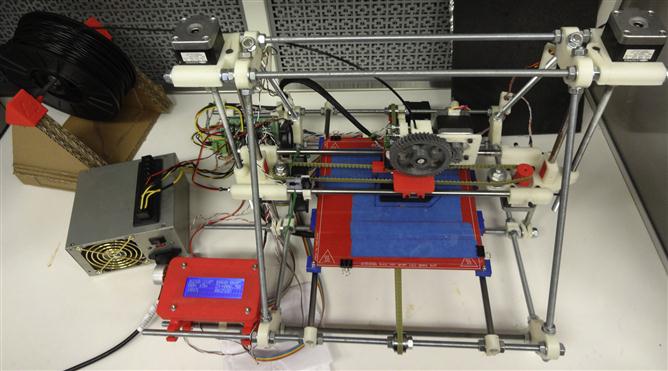
FIGURE 1.2 A self-replicating rapid prototyper known as the RepRap can 3-D print about 50% of its own parts (including the component being fabricated) and numerous scientific tools and components. All the red, white and gray components were printed on other RepRaps to make this highly customized version of the Mendel Prusa developed by Jerry Anzalone.
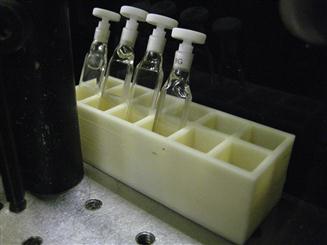
FIGURE 1.3 Parametric cuvette and vial rack. Source: Open sourced by Emanresu (http://www.thingiverse.com/thing:25080).
Combination devices have also been developed where a 3-D print is coupled to an existing hardware tool (such as the portable cell lysis device for DNA extraction shown in Figure 1.4), which is a 3-D printable adapter that converts a Craftsman automatic hammer into a bead grinder for use with DNA extraction.
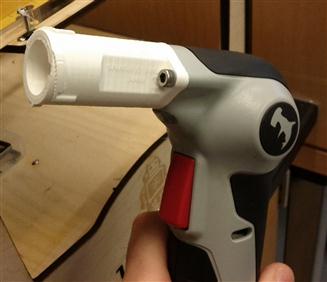
FIGURE 1.4 A 3-D printable adapter to turn a craftsman automatic hammer into a bead grinder for use with DNA extraction. Source: Open sourced by Russell Neches at U.C. Davis (http://www.thingiverse.com/thing:18289).
Similarly, the DremelFuge chuck shown in Figure 1.5 is a 3-D printable rotor for centrifuging standard microcentrifuge tubes and mini-prep columns powered by a Dremel drill.
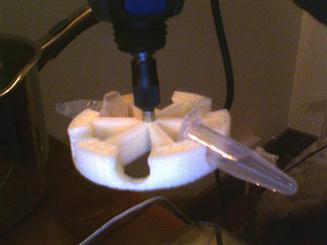
FIGURE 1.5 The DremelFuge, a 3-D printable rotor for centrifuging standard microcentrifuge tubes and mini-prep columns powered by a Dremel drill. Source: Designed and open sourced by Cathal Garvey (http://www.thingiverse.com/thing:1483).
These combination devices can radically reduce research costs. For example, the DremelFuge can be used in the lab or the field as an extremely inexpensive centrifuge (price: <$50, primarily for the Dremel drill—compared to commercial centrifuges systems, which cost a few hundred dollars).
The most aggressive savings can come from coupling Arduino controls to 3-D prints to make open-source scientific hardware. Consider the Arduino-controlled open-source orbital shaker in Figure 1.6, used for mammalian cell and tissue culture and bench-top science. The <$200 open-source orbital shaker fits inside a standard 37 °C/5% CO2 cell incubator and replaces commercial versions that start over $1000—a factor of 5X savings. As the scientific tools that are open-sourced gain complexity, the cost differential becomes even more severe.
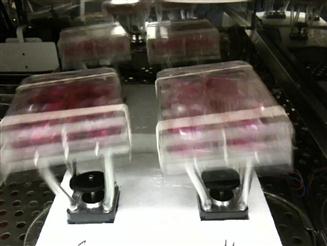
FIGURE 1.6 Open-source orbital shaker using 3-D printable components. Source: Open sourced by Jordan Miller at the University of Pennsylvania (http://www.thingiverse.com/thing:5045).
For example, as seen in Figure 1.7, it is now possible to make a <$50 customizable automated filter wheel that replaces a $2500 commercial version (or a factor of 50X savings). The filter wheel changer in Figure 1.7 uses an open-source Arduino microcontroller to operate. All of the code to make and use it is open-source, including the design files, which are scripted in OpenSCAD, itself an open-source software tool. It was written carefully in OpenSCAD to be parametric, so other scientists can easily adjust the number or size of filters for their specific applications. A few months after it was published, the designs had been downloaded over 750 times, and presumably in use in labs throughout the world.
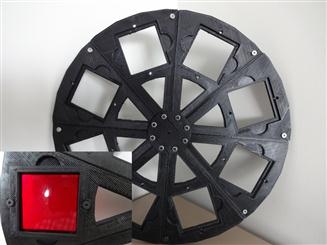
FIGURE 1.7 Parametric automated filter wheel changer. Inset shows detail of filter locking. Source: Open sourced by the author, Rodrigo Faria and Nick Anzalone of the Michigan Technological University Open Sustainability Technology Group (http://www.thingiverse.com/thing:26553).
As additional research groups begin to freely share the designs of their own laboratory hardware, not only can everyone in the greater scientific community enjoy those same discounts on equipment, but also following the FOSS approach, the equipment will continue to evolve to be even better in the open-source scientific design community. In addition, research costs will also be depressed even when scientists choose a commercial version of a tool because of the price pressure from the open-source community.
We are on the verge of a new era where low-cost scientific equipment puts increasingly sophisticated tools into the hands of the public and amateur scientists, while driving down the costs of research tools at our most prestigious laboratories.
References
1. Pearce Joshua M. Building research equipment with free, open-source hardware. Science. 2012;337(6100):1303–1304.
2. Bretthauer DW. Open source software: a history. Inf Technol Libr. 2002;21(1):3–10.
3. Moon JY, Sproull L. Essence of distributed work: the case of the Linux kernel. First Monday. 2000;5 Retrieved 25.01.13, from http://firstmonday.org/htbin/cgiwrap/bin/ojs/index.php/fm/article/view/801/710; 2000.
4. Raymond ES. The cathedral and the bazaar. First Monday. 1988;3 Retrieved 25.01.13, from: http://firstmonday.org/htbin/cgiwrap/bin/ojs/index.php/fm/article/view/578/499; 1988.
5. The Open Source Definition (Version 1.9). Open source initiative. Retrieved 25.01.13, from: http://opensource.org/docs/definition.html.
6. Bonaccorsi A, Rossi C. Why open source software can succeed. Res Policy. 2003;32:1243–1258.
7. Kogut B, Metiu A. Open-source software development and distributed innovation. Oxford Rev Econ Policy. 2001;17(2):248–264.
8. Giles J. Internet encyclopaedias go head to head. Nature. 2005;438:900–901.
9. Silverman M. Encyclopedia Britannica vs Wikipedia. [Infographic] [WWW Document], Mashable 2012; Retrieved 25.02.13, from: http://mashable.com/2012/03/16/encyclopedia-britannica-wikipedia-infographic/; 2012.
10. Mockus A, Fielding RT, Herbsleb JD. Two cases studies of open source software development: Apache and Mozilla. ACM Trans Software Eng Methodol. 2002;11(3):309–346.
11. Deek FP, McHugh JAM. Open source: technology and policy. New York, NY: Cambridge University Press; 2007.
12. Weber S. The success of open source. Cambridge, MA: Harvard University Press; 2004.
13. Pearce JM. Appropedia as a tool for service learning in sustainable development. J Educ Sustainable Dev. 2009;3(1):47–55.
14. Christian W, Esquembre F, Barbato L. Open source physics. Science. 2011;334:1077–1078.
15. Pearce JM, Mushtaq U. Overcoming technical constraints for obtaining sustainable development with open source appropriate technology, science and technology for humanity (TIC-STH). 2009 IEEE Toronto International Conference 2009; pp. 814–820.
16. Buitenhuis AJ, Zelenika I, Pearce JM. Open design-based strategies to enhance appropriate technology development. In: Proceedings of the fourteenth annual national collegiate inventors and innovators alliance conference. 2010; 25–27: P. 1–2, March, 2010.
17. Zelenika I, Pearce JM. Barriers to appropriate technology growth in sustainable development. J Sustainable Dev. 2011;4(6):12–22.
18. Pearce JM. The case for open source appropriate technology. Environ, Dev Sustainability. 2012;14:425–431.
19. Stokstad E. Open-source ecology takes root across the world. Science. 2011;334:308–309.
20. Bruns B. Open sourcing nanotechnology research and development: issues and opportunities. Nanotechnology. 2001;12:198–210.
21. Mushtaq U, Pearce JM. Open source appropriate nanotechnology. In: Maclurcan D, Radywyl N, eds. Nanotechnology and global sustainability. New York, NY: CRC Press; 2012;191–213.
22. Pearce JM. Make nanotechnology research open-source. Nature. 2012;491:519–521.
23. Lang T. Advancing global health research through digital technology and sharing data. Science. 2011;331:714–717.
24. Meister S, Plouffe DM, Kuhen KL, et al. Imaging of plasmodium liver stages to drive next-generation antimalarial drug discovery. Science. 2011;334:1372–1377.
25. Woelfle M, Olliaro P, Todd MH. Open science is a research accelerator. Nat Chem. 2011;3(10):745–748.
26. Nielsen M. Reinventing discovery: the new era of networked science. Princeton University Press 2011.
27. Pearce JM. Open source research in sustainability. Sustainability: J Rec. 2012;5(4):238–243.
28. Jones R, Haufe P, Sells E, et al. RepRap – the replicating rapid prototyper. Robotica. 2011;29:177–191.
29. Symes MD, Kitson PJ, Yan J, et al. Integrated 3D-printed reactionware for chemical synthesis and analysis. Nat Chem. 2012;4:349–354.
30. Metz C. Microsoft embraces elephant of open source. Wired 2011; Retrieved 25.02.13, from: http://www.wired.com/wiredenterprise/2011/10/microsoft-and-hadoop/; 2011.
1Although the term “hacker” is often associated with illicit activity in public discourse, it actually refers to a computer programmer who develops free and open-source software.
2Ubuntu is a computer operating system based on the Debian Linux distribution and distributed as free and open-source software, using its own desktop environment. It is the most popular version of Linux with over 20 million people using it as of 2012. Ubuntu is a South African ethical ideology focusing on people’s allegiances and relations with each other. Rough translations of the principle of ubuntu is “humanity towards others” or “the belief in a universal bond of sharing that connects all humanity”. Ubuntu, the operating system can be downloaded for free from http://www.ubuntu.com/ and Debian from http://www.debian.org/.
3In fact, even Microsoft is now embracing some components of open-source software development. A Microsoft representative has recently stated that both SQL Server and the Windows Azure teams are committed to the Hadoop open-source platform for the long term [30].
5http://www.cooking-hacks.com/index.php/documentation/tutorials/geiger-counter-arduino-radiation-sensor-board.
6http://phduino.blogspot.com/.
7http://code.google.com/p/xoscillo/.
9If you have never seen a RepRap work, put this book down and go to http://reprap.org/—click on the video and then come back.
